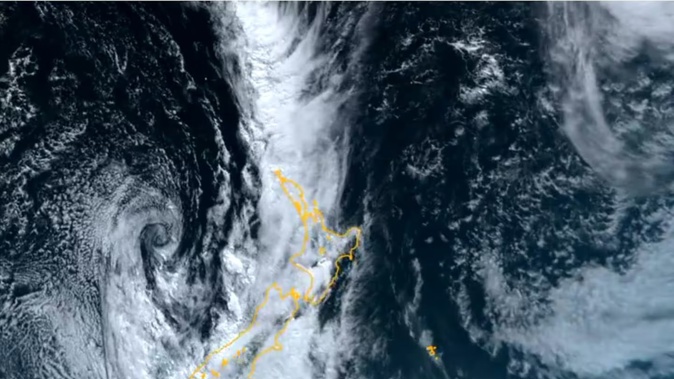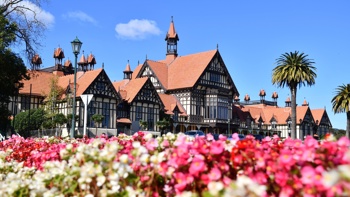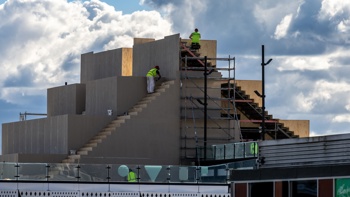
They’ve powered some of our biggest deluges in recent years and caused disastrous floods: so what are “atmospheric rivers” and how do they affect us?
We can think of them as long, thin filaments of atmospheric moisture - or highways of water vapour in the sky - snaking thousands of kilometres between the tropics and the mid-latitudes, where New Zealand sits.
They’re capable of carrying double the average flow of the Amazon River – or 200 times that of our largest river, the Clutha/Mata Au.
Around 40 atmospheric rivers make landfall here every year, with four or five classified as strong and usually hitting around summer.
But these giant rain-makers could strike in winter, as dramatically shown by a deluge that put swathes of Canterbury farmland underwater in 2021, and another that forced the evacuation of half of Westport.
“Atmospheric rivers are most common in the southwest of New Zealand, but can occur anywhere in New Zealand,” Niwa meteorologist Tristan Meyers previously explained.
When these atmospheric rivers encountered other weather features or New Zealand’s mountainous terrain, the vast amount of water vapour within them could get “squeezed” out, falling as heavy rain or snow.
Atmospheric rivers also happened to be important to New Zealand’s water supply; for the West Coast of the South Island, they were estimated to bring more than three quarters of total rainfall.
“However, they are also responsible for extreme rainfall events; up to 94 per cent of extreme precipitation on the west coast of the South Island are from atmospheric rivers.”
Scientists have been investigating whether atmospheric rivers have been increasing in New Zealand as our planet warms.
- 'Atmospheric river' may bring more than a month's rain in three days
- 'Atmospheric river' brings relief for drought-stricken farmers
“But I’d speculate that it’s in-line with what we would expect from climate change; for every degree of warming, the amount of water vapour in the atmosphere can increase by about seven per cent,” Meyers said.
Natural climate drivers mattered too: and a La Niña climate system and a negative Indian Ocean Dipole were two key factors behind atmospheric rivers of the last few years.
For scientists, another of the biggest questions has been what links atmospheric rivers have to different local weather types over the country.
According to a Niwa-led study back in 2000, there happened to be 12 main types of weather in our region – each associated with different configurations of high and low pressure systems.
More recently, scientists have better defined these weather types to provide a more nuanced picture of how temperature and precipitation varied across the country.
“But we’ve also found that extreme rainfall can be caused by many different weather types,” Otago University senior lecturer Dr Daniel Kingston told the Herald last year.
“This suggests that weather types may not be the only factor that cause extreme rain events.”
One recent analysis co-authored by Kingston concluded that atmospheric rivers which affected the south were different beasts to those in the north.
For the north, moisture coming from the subtropical Tasman Sea is the most important, whereas in the the south, the main driver of atmospheric rivers is the strength of the westerly winds across the Southern Ocean.
The study also found these events could occur under three or four weather types in each part of the country – but again, the picture was somewhat messy.
While weather types linked to generally wet conditions were most often associated with them, that wasn’t always the case.
“Surprisingly, they can also occur during weather types more commonly linked with average or drier than average conditions,” Kingston said.
That study also explored links to climate change, finding there were some general patterns we could draw.
One was westerly winds shifting further southward – something that’s already been caused by ozone depletion over Antarctica – which would in turn shift the location of high and low pressure systems in our atmosphere.
Another, as Meyers pointed out, found each additional degree of global warming meant the atmosphere could more moisture.
“This explains why, under climate change, rainfall extremes should intensify,” Kingston said.
“The same will happen to atmospheric rivers: they’re expected to include more moisture under warmer conditions in the future.”
Jamie Morton is a specialist in science and environmental reporting. He joined the Herald in 2011 and writes about everything from conservation and climate change to natural hazards and new technology.
This article was originally published on the NZ Herald here.
Take your Radio, Podcasts and Music with you









